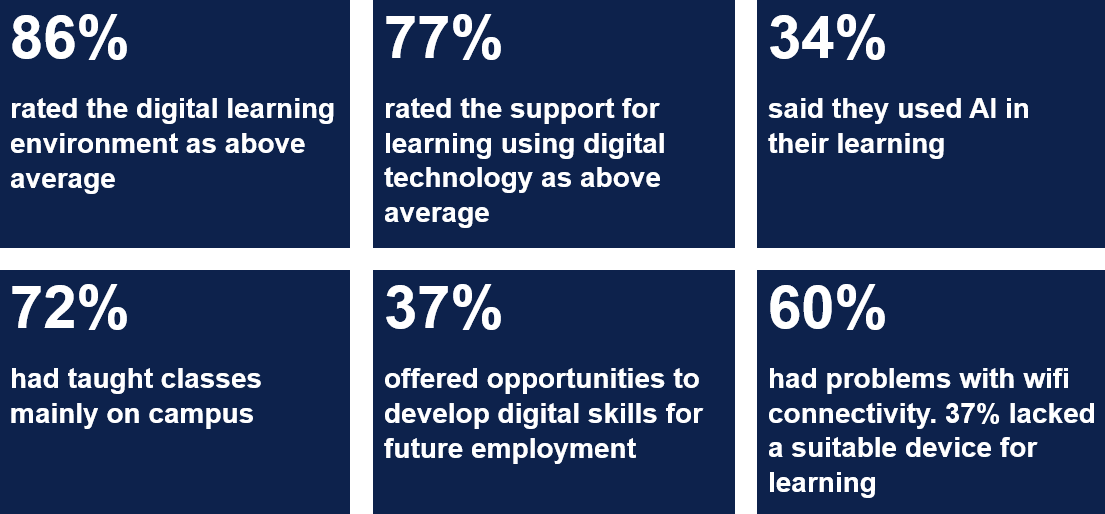2024/25 UK higher education students digital experience insights survey findings
The digital experience insights survey for higher education students took place between October 2024 and April 2025. Participating organisations were able to select their own survey period within these dates, typically a three to four week window.
There were 15,398 respondents from 30 different organisations (24 universities and six colleges offering higher education degrees). 23 of these were based in England, four in Scotland, two in Wales and one in Northern Ireland. These 30 organisations represent 9% of all higher education providers in the UK.
The highest number of responses from a single organisation was 5,550 students. The mean number of responses was 513 per organisation and the median was 265 per organisation. 9 of the 30 organisations contributed fewer than 100 responses.
A survey indicating the digital experience of further education learners was run simultaneously and results can be found in our 2024/25 FE learners report.
Through Jisc’s digital experience insights service, organisations can gain valuable data to inform strategic, operational and digital investment decisions, evidence year-on-year improvements and demonstrate return on investment. Organisations that take part have access to their own data to assess their unique situations as well as benchmarking data. Full information about the digital experience insights surveys is detailed on our information page.
Executive summary

The 2024/25 digital experience insights survey for UK higher education students gathered responses from a broad and diverse student population, offering a detailed picture of how digital technologies are shaping learning experiences across the sector. The findings reflect both continuity and change. While many indicators of digital provision and support remain strong or have improved, persistent challenges and emerging expectations signal areas for further improvement.
This year, 86% of students rated their digital learning environment as above average, and 84% rated the quality of the digital learning experience on their course positively. These figures represent a continuation of the upward trend of positive ratings seen in recent years. Similarly, more than three-quarters (77%) of students rated the support they received for learning using technology as above average, a 5% increase from last year. These improvements suggest that the investment of universities in digital infrastructure and support is benefiting students and enhancing their digital learning experiences.
Students continue to value the flexibility, accessibility, and convenience of digital learning. Recorded lectures, virtual learning environments, and tools that enabled collaboration were frequently cited as enabling more personalised and self-directed learning. However, this year’s survey again highlighted a growing tension between the benefits of digital learning and the desire for in-person interaction and community. More students reported that teaching was delivered mainly on campus this year (72%, compared to 67% last year), while nearly half (48%) of students preferred a blended or wholly online approach, and a similar percentage (46%) preferred to study mainly online when not in class.
Despite high satisfaction levels, significant barriers remain. Three-fifths (60%) of students reported wifi connectivity issues either on or off campus, and nearly two-fifths (37%) lacked access to a suitable device at some point during their studies, which impacted their ability to learn. These issues were more acute for international students and those from minority ethnic groups. Cost of living pressures also continued to impact students’ ability to engage fully with their studies, with 39% taking on paid work that may have affected their academic progress. The flexibility in learning demanded by some students’ personal circumstances makes seamless access to digital course related content even more important.
The use of artificial intelligence (AI) in learning has grown rapidly when compared to the results of last year’s survey. 34% of students reported using AI tools as part of their learning, and 23% were provided access to AI platforms by their institution. However, students expressed both enthusiasm and concern about the use of AI in their learning, particularly around academic integrity, information reliability, and the need for clearer guidance and consistent messaging from staff.
Overall support for digital skills development remains uneven. While over half of students (55%) received guidance on course-related digital skills, fewer were offered opportunities to develop skills for employment (37%), to receive formal certification or accreditation for their digital skills (27%), or an assessment of their training needs (34%). International students and those newer to their institutions were more likely to report receiving support.
Students continue to call for improvements in platform usability, wifi infrastructure, device access, and training opportunities. They also want more consistent and inclusive approaches to digital learning, with clearer communication about available support. Addressing these areas will be key to ensuring that digital learning remains equitable, engaging, and effective for all students. Throughout the report, we highlight instances where some student demographics may have faced disadvantages. Where possible, we also highlight the differing UK and international student experience.
By addressing the concerns raised by students, organisations have an opportunity to foster a more inclusive and supportive environment for the use of digital technologies in learning. Universities should of course seek to maintain the highly positive ratings in areas of the digital environment and digital experience, but should also explore ways of increasing the support provided to students around digital skills development where ratings were comparatively lower.
Full report
Download our 2024/25 UK higher education (HE) students digital experience insights survey findings [pdf].